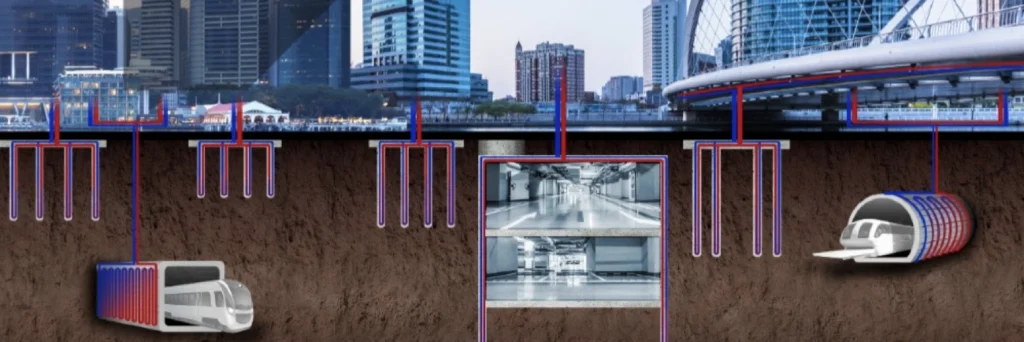Converting Australian underground structures into energy extraction systems
Dr Asal Bidarmaghz
The opportunity
Urban subsurface has demonstrated a significant temperature rise associated with the rapid rate of underground development in major cities around the world [Fig. 1]. Exploiting the additional heat in the underground has been proposed to address the heating demands. For example, Germany shows that the rise in groundwater temperature equals the City’s annual thermal demand. Extracting the accumulated heat in the subsurface for heating spaces in winter will provide the thermal capacity in the ground for rejecting heat from building spaces to the ground in the summer, hence being used for both heating and cooling purposes. Given the current underground infrastructure projects in Australia, it is an excellent opportunity to transform underground structures like basements, car parks, and tunnels into energy extraction systems to heat and cool buildings – with minimal additional costs.

Objectives
These systems will improve structural durability and ground stability while providing heating and cooling energy for buildings. In summary, they will:
- Mitigate thermally induced settlement and deformation in the ground and structures, temperature-driven groundwater contamination and inefficiency in underground ventilation due to significantly high temperatures in the surrounding soil – by maintaining the subsurface and aquifer temperatures within an acceptable range.
- Decrease the magnitude of the urban heat island effect associated with CO2 emission which will in turn mitigate the upwarding air temperature increase in cities.

A different approach
The energy extraction systems use circulating cold water in winter and hot water in summer through heat absorber pipes in a structure’s walls [Fig. 2 and 3]. Taking advantage of natural temperature differences between underground elements and the environment, the water temperature change is enhanced by a Ground Source Heat Pump (GSHP) to provide heating and cooling energy for nearby buildings. Utilising this renewable energy can significantly contribute to Australia’s climate targets, with just one kilometre of a tunnel meeting the heating and cooling needs of 150 apartments and reducing carbon emissions in heating and cooling by approximately 75%.

Key learnings
- The additional cost of converting existing underground structures into energy extraction systems is negligible.
- The associated risks for the installation and operation of these systems are proven to be negligible.
- These systems can regulate ground temperature hence mitigating thermally induced changes in the ground and structures.
- If 10% of around 3,000 schools in NSW, specifically those located in the vicinity of underground structures, utilise an underground energy extraction system then CO2 emissions will be reduced by 200,000 tonnes per year. The financial benefits of this would be large too, specifically a ∼$50M saving per year to the NSW government. This could also lead to ∼45/year fewer deaths in NSW alone and ∼135/year nationwide [2].
International examples
Vienna Metro — Austria
A section of a cut and cover tunnel – Vienna metro station – comprising 59 bored piles was thermally activated to supply heating for an adjacent school, with an extractable thermal power of about 150 kW in the long term. The annual savings in operation costs of 10,000 € was achieved – compared to the natural gas heating system [4].
Turino Metro – Italy
As a testing facility, two lining rings from the Line 1 of Turin Metro, Italy were thermally activated. Absorber pipes were attached to the prefabricated reinforcement cages inside the segments. This system yielded around 85 kW of heating and cooling energy [5].
References
- Dai X., Bidarmaghz A., (2023), Energy tunnels: A review of the state of the art and knowledge gaps to harness renewable energy from underground infrastructure, Tunnelling and Underground Space Technology 142, 105431
- Bidarmaghz A., Choudhary R., Soga K., (2021), Impacts of underground climate change on urban geothermal potential: Lessons learnt from a case study in London, Science of The Total Environment, 778, 146-196, Elsevier.
- Laloui, L., Di Donna A., (2013), Energy geostructures: innovation in underground engineering, John Wiley and sons.
- Brandl, H.J.P.e., (2016), Geothermal geotechnics for urban undergrounds, 165: p. 747-764.
- Barla, M., A. Di Donna, A.J.T. Insana, et al., (2019), A novel real-scale experimental prototype of energy tunnel, 87: p. 1-14.